Cohen I.M., Kundu P.K. Fluid Mechanics
Подождите немного. Документ загружается.


562 Turbulence
(which may be taken equal to the rms fluctuating speed). Then the time scale of large
eddies is of order l/u
. Observations show that the large eddies lose much of their
energy during the time they turn over one or two times, so that the rate of energy
transferred from large eddies is proportional to u
2
times their frequency u
/l. The
dissipation rate must then be of order
ε ∼
u
3
l
,
(13.38)
signifying that the viscous dissipation is determined by the inviscid large-scale
dynamics of the turbulent field.
Kolmogorov suggested in 1941 that the size of the dissipating eddies depends
on those parameters that are relevant to the smallest eddies. These parameters are the
rate ε at which energy has to be dissipated by the eddies and the diffusivity ν that
does the smearing out of the velocity gradients. As the unit of ε is m
2
/s
3
, dimensional
reasoning shows that the length scale formed from ε and ν is
η =
ν
3
ε
1/4
,
(13.39)
which is called the Kolmogorov microscale. A decrease of ν merely decreases the scale
at which viscous dissipation takes place, and not the rate of dissipation ε. Estimates
show that η is of the order of millimeters in the ocean and the atmosphere. In laboratory
flows the Kolmogorov microscale is much smaller because of the larger rate of viscous
dissipation. Landahl and Mollo-Christensen (1986) give a nice illustration of this.
Suppose we are using a 100-W household mixer in 1 kg of water. As all the power is
used to generate the turbulence, the rate of dissipation is ε = 100 W/kg = 100 m
2
/s
3
.
Using ν = 10
−6
m
2
/s for water, we obtain η = 10
−2
mm.
9. Spectrum of Turbulence in Inertial Subrange
In Section 4 we defined the wavenumber spectrum S(K), representing turbulent
kinetic energy as a function of the wavenumber vector K. If the turbulence is isotropic,
then the spectrum becomes independent of the orientation of the wavenumber vector
and depends on its magnitude K only. In that case we can write
u
2
=
∞
0
S(K) dK.
In this section we shall derive the form of S(K) in a certain range of wavenumbers
in which the turbulence is nearly isotropic.
Somewhat vaguely, we shall associate a wavenumber K with an eddy of size K
−1
.
Small eddies are therefore represented by large wavenumbers. Suppose l is the scale
of the large eddies, which may be the width of the boundary layer. At the relatively
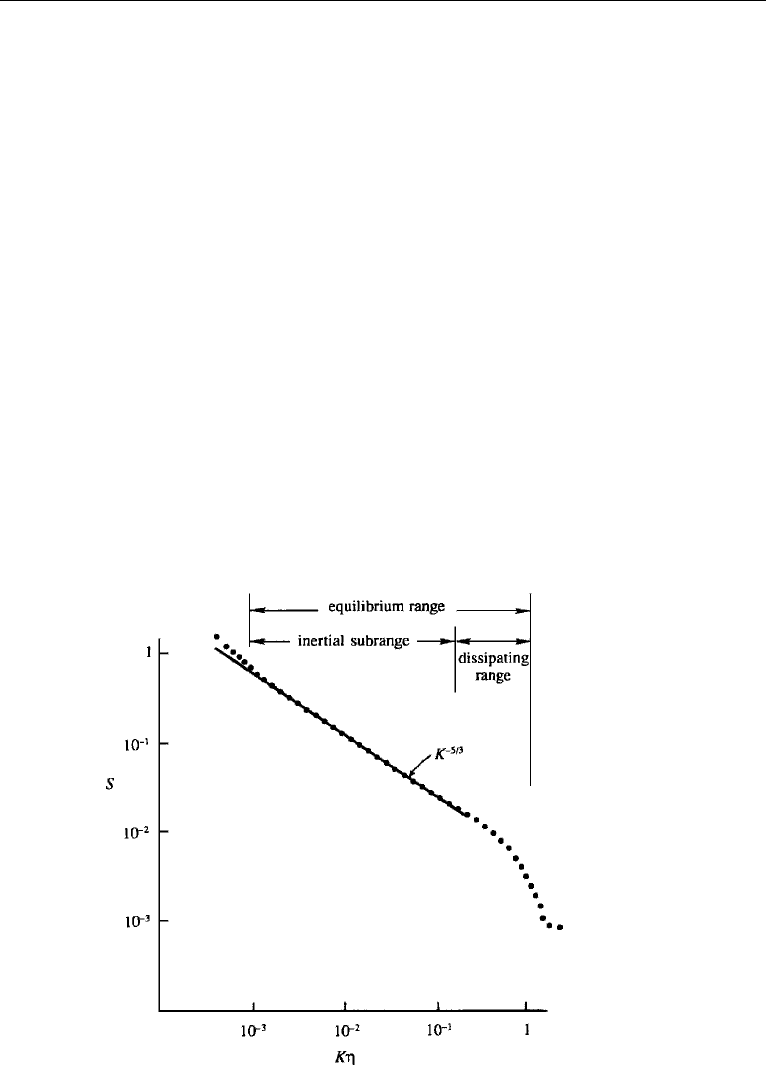
9. Spectrum of Turbulence in Inertial Subrange 563
small scales represented by wavenumbers K l
−1
, there is no direct interaction
between the turbulence and the motion of the large, energy-containing eddies. This is
because the small scales have been generated by a long series of small steps, losing
information at each step. The spectrum in this range of large wavenumbers is nearly
isotropic, as only the large eddies are aware of the directions of mean gradients. The
spectrum here does not depend on how much energy is present at large scales (where
most of the energy is contained), or the scales at which most of the energy is present.
The spectrum in this range depends only on the parameters that determine the nature
of the small-scale flow, so that we can write
S = S(K,ε, ν) K l
−1
.
The range of wavenumbers K l
−1
is usually called the equilibrium range. The
dissipating wavenumbers with K ∼ η
−1
, beyond which the spectrum falls off very
rapidly, form the high end of the equilibrium range (Figure 13.12). The lower end
of this range, for which l
−1
K η
−1
, is called the inertial subrange, as only
the transfer of energy by inertial forces (vortex stretching) takes place in this range.
Both production and dissipation are small in the inertial subrange. The production of
energy by large eddies causes a peak of S at a certain K l
−1
, and the dissipation
of energy causes a sharp drop of S for K>η
−1
. The question is, how does S vary
with K between the two limits in the inertial subrange?
Figure 13.12 A typical wavenumber spectrum observed in the ocean, plotted on a log–log scale. The
unit of S is arbitrary, and the dots represent hypothetical data.

564 Turbulence
Kolmogorov argued that, in the inertial subrange part of the equilibrium range,
S is independent of ν also, so that
S = S(K,ε) l
−1
K η
−1
.
Although little dissipation takes place in the inertial subrange, the spectrum here does
depend on ε. This is because the energy that is dissipated must be transferred across
the inertial subrange, from low to high wavenumbers. As the unit of S is m
3
/s
2
and
that of ε is m
2
/s
3
, dimensional reasoning gives
S = Aε
2/3
K
−5/3
l
−1
K η
−1
, (13.40)
where A 1.5 has been found to be a universal constant, valid for all turbulent
flows. Equation (13.40) is usually called Kolmogorov’s K
−5/3
law. If the Reynolds
number of the flow is large, then the dissipating eddies are much smaller than the
energy-containing eddies, and the inertial subrange is quite broad.
Because very large Reynolds numbers are difficult to generate in the laboratory,
the Kolmogorov spectral law was not verified for many years. In fact, doubts were
being raised about its theoretical validity. The first confirmation of the Kolmogorov
law came from the oceanic observations of Grant et al. (1962), who obtained a velocity
spectrum in a tidal flow through a narrow passage between two islands near the west
coast of Canada. The velocity fluctuations were measured by hanging a hot film
anemometer from the bottom of a ship. Based on the depth of water and the average
flow velocity, the Reynolds number was of order 10
8
. Such large Reynolds numbers
are typical of geophysical flows, since the length scales are very large. The K
−5/3
law has since been verified in the ocean over a wide range of wavenumbers, a typical
behavior being sketched in Figure 13.12. Note that the spectrum drops sharply at
Kη ∼ 1, where viscosity begins to affect the spectral shape. The figure also shows
that the spectrum departs from the K
−5/3
law for small values of the wavenumber,
where the turbulence production by large eddies begins to affect the spectral shape.
Laboratory experiments are also in agreement with the Kolmogorov spectral law,
although in a narrower range of wavenumbers because the Reynolds number is not as
large as in geophysical flows. The K
−5/3
law has become one of the most important
results of turbulence theory.
10. Wall-Free Shear Flow
Nearly parallel shear flows are divided into two classes—wall-free shear flows and
wall-bounded shear flows. In this section we shall examine some aspects of turbulent
flows that are free of solid boundaries. Common examples of such flows are jets,
wakes, and shear layers (Figure 13.13). For simplicity we shall consider only plane
two-dimensional flows. Axisymmetric flows are discussed in Townsend (1976) and
Tennekes and Lumley (1972).
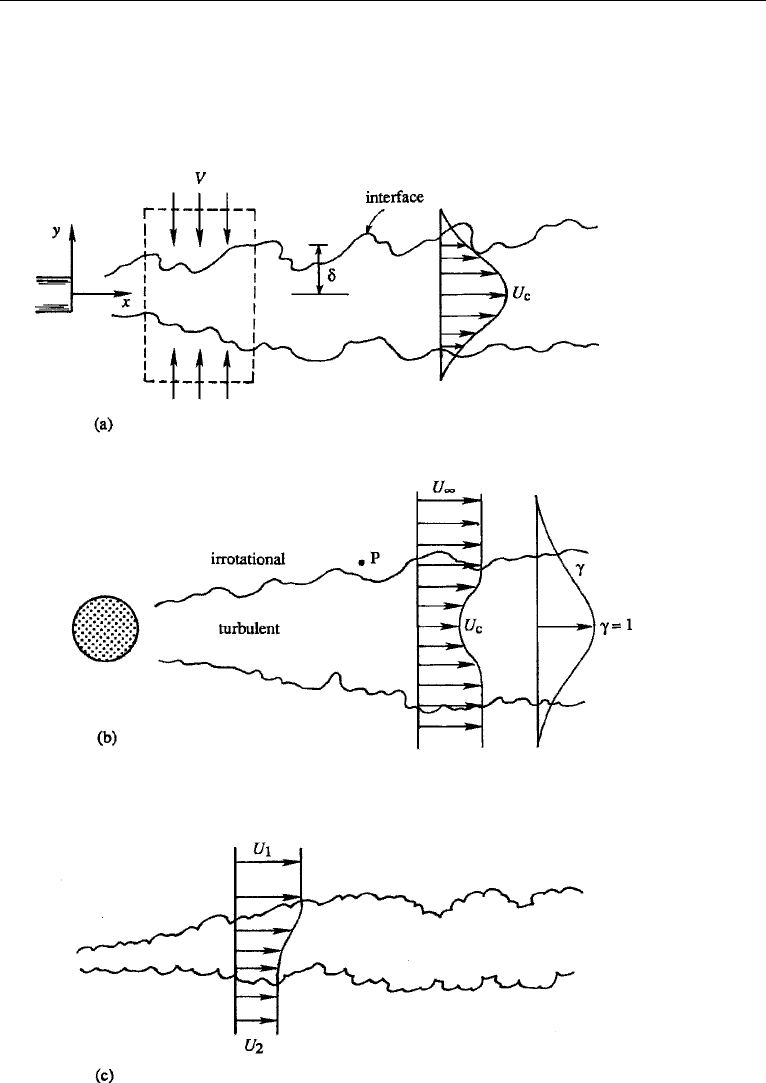
10. Wall-Free Shear Flow 565
Intermittency
Consider a turbulent flow confined to a limited region. To be specific we shall consider
the example of a wake (Figure 13.13b), but our discussion also applies to a jet, a shear
layer, or the outer part of a boundary layer on a wall. The fluid outside the turbulent
Figure 13.13 Three types of wall-free turbulent flows: (a) jet; (b) wake; and (c) shear layer.
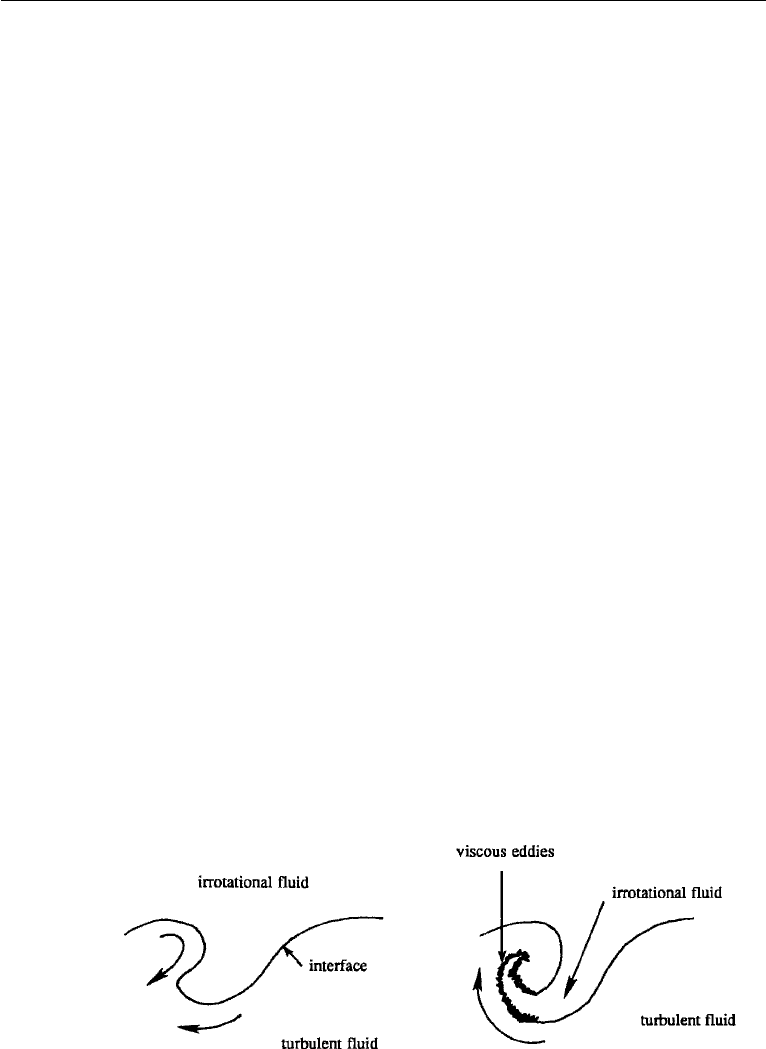
566 Turbulence
region is either in irrotational motion (as in the case of a wake or a boundary layer), or
nearly static (as in the case of a jet). Observations show that the instantaneous interface
between the turbulent and nonturbulent fluid is very sharp. In fact, the thickness of the
interface must equal the size of the smallest scales in the flow, namely the Kolmogorov
microscale. The interface is highly contorted due to the presence of eddies of various
sizes. However, a photograph exposed for a long time does not show such an irregular
and sharp interface but rather a gradual and smooth transition region.
Measurements at a fixed point in the outer part of the turbulent region (say at
point P in Figure 13.13b) show periods of high-frequency fluctuations as the point P
moves into the turbulent flow and quiet periods as the point moves out of the turbulent
region. Intermittency γ is defined as the fraction of time the flow at a point is turbulent.
The variation of γ across a wake is sketched in Figure 13.13b, showing that γ = 1
near the center where the flow is always turbulent, and γ = 0 at the outer edge of
the flow.
Entrainment
A flow can slowly pull the surrounding irrotational fluid inward by “frictional” effects;
the process is called entrainment. The source of this “friction” is viscous in laminar
flow and inertial in turbulent flow. The entrainment of a laminar jet was discussed in
Chapter 10, Section 12. The entrainment in a turbulent flow is similar, but the rate is
much larger. After the irrotational fluid is drawn inside a turbulent region, the new
fluid must be made turbulent. This is initiated by small eddies (which are dominated
by viscosity) acting at the sharp interface between the turbulent and the nonturbulent
fluid (Figure 13.14).
The foregoing discussion of intermittency and entrainment applies not only to
wall-free shear flows but also to the outer edge of boundary layers.
Self-Preservation
Far downstream, experiments show that the mean field in a wall-free shear flow
becomes approximately self-similar at various downstream distances. As the mean
field is affected by the Reynolds stress through the equations of motion, this means that
the various turbulent quantities (such as Reynolds stress) also must reach self-similar
Figure 13.14 Entrainment of a nonturbulent fluid and its assimilation into turbulent fluid by viscous
action at the interface.

10. Wall-Free Shear Flow 567
states. This is indeed found to be approximately true (Townsend, 1976). The flow is
then in a state of “moving equilibrium,” in which both the mean and the turbulent
fields are determined solely by the local scales of length and velocity. This is called
self-preservation. In the self-similar state, the mean velocity at various downstream
distances is given by
U
U
c
= f
y
δ
(jet),
U
∞
− U
U
∞
− U
c
= f
y
δ
(wake),
U − U
1
U
2
− U
1
= f
y
δ
(shear layer).
(13.41)
Here δ(x) is the width of flow, U
c
(x) is the centerline velocity for the jet and the wake,
and U
1
and U
2
are the velocities of the two streams in a shear layer (Figure 13.13).
Consequence of Self-Preservation in a Plane Jet
We shall now derive how the centerline velocity and width in a plane jet must vary if
we assume that the mean velocity profiles at various downstream distances are self
similar. This can be done by examining the equations of motion in differential form.
An alternate way is to examine an integral form of the equation of motion, derived in
Chapter 10, Section 12. It was shown there that the momentum flux M = ρ
U
2
dy
across the jet is independent of x, while the mass flux ρ
Udyincreases downstream
due to entrainment. Exactly the same constraint applies to a turbulent jet. For the
sake of readers who find cross references annoying, the integral constraint for a
two-dimensional jet is rederived here.
Consider a control volume shown by the dotted line in Figure 13.13a, in which the
horizontal surfaces of the control volume are assumed to be at a large distance from
the jet axis. At these large distances, there is a mean V field toward the jet axis due to
entrainment, but no U field. Therefore, the flow of x-momentum through the horizon-
tal surfaces of the control volume is zero. The pressure is uniform throughout the flow,
and the viscous forces are negligible. The net force on the surface of the control vol-
ume is therefore zero. The momentum principle for a control volume (see Chapter 4,
Section 8) states that the net x-directed force on the boundary equals the net rate of
outflow of x-momentum through the control surfaces. As the net force here is zero,
the influx of x-momentum must equal the outflow of x-momentum. That is
M = ρ
∞
−∞
U
2
dy = independent of x, (13.42)
where M is the momentum flux of the jet (=integral of mass flux ρU dy times veloc-
ity U ). The momentum flux is the basic externally controlled parameter for a jet and
is known from an evaluation of equation (13.42) at the orifice opening. The mass flux
ρ
Udyacross the jet must increase because of entrainment of the surrounding fluid.

568 Turbulence
The assumption of self similarity can now be used to predict how δ and U
c
in a
jet should vary with x. Substitution of the self-similarity assumption (13.41) into the
integral constraint (13.42) gives
M = ρU
2
c
δ
∞
−∞
f
2
d
y
δ
.
The preceding integral is a constant because it is completely expressed in terms of
the nondimensional function f(y/δ).AsM is also a constant, we must have
U
2
c
δ = const. (13.43)
At this point we make another important assumption. We assume that the
Reynolds number is large, so that the gross characteristics of the flow are independent
of the Reynolds number. This is called Reynolds number similarity. The assumption
is expected to be valid in a wall-free shear flow, as viscosity does not directly affect
the motion; a decrease of ν, for example, merely decreases the scale of the dissipat-
ing eddies, as discussed in Section 8. (The principle is not valid near a smooth wall,
and as a consequence the drag coefficient for a smooth flat plate does not become
independent of the Reynolds number as Re →∞; see Figure 10.12.) For large Re,
then, U
c
is independent of viscosity and can only depend on x, ρ, and M:
U
c
= U
c
(x,ρ,M).
A dimensional analysis shows that
U
c
∝
M
ρx
( jet), (13.44)
so that equation (13.43) requires
δ ∝ x(jet). (13.45)
This should be compared with the δ ∝ x
2/3
behavior of a laminar jet, derived in
Chapter 10, Section 12. Experiments show that the width of a turbulent jet does grow
linearly, with a spreading angle of 4
◦
.
For two-dimensional wakes and shear layers, it can be shown (Townsend, 1976;
Tennekes and Lumley, 1972) that the assumption of self similarity requires
U
∞
− U
c
∝ x
−1/2
,δ∝
√
x (wake),
U
1
− U
2
= const., δ ∝ x (shear layer).
Turbulent Kinetic Energy Budget in a Jet
The turbulent kinetic energy equation derived in Section 7 will now be applied to
a two-dimensional jet. The energy budget calculation uses the experimentally mea-
sured distributions of turbulence intensity and Reynolds stress across the jet. There-
fore, we present the distributions of these variables first. Measurements show that
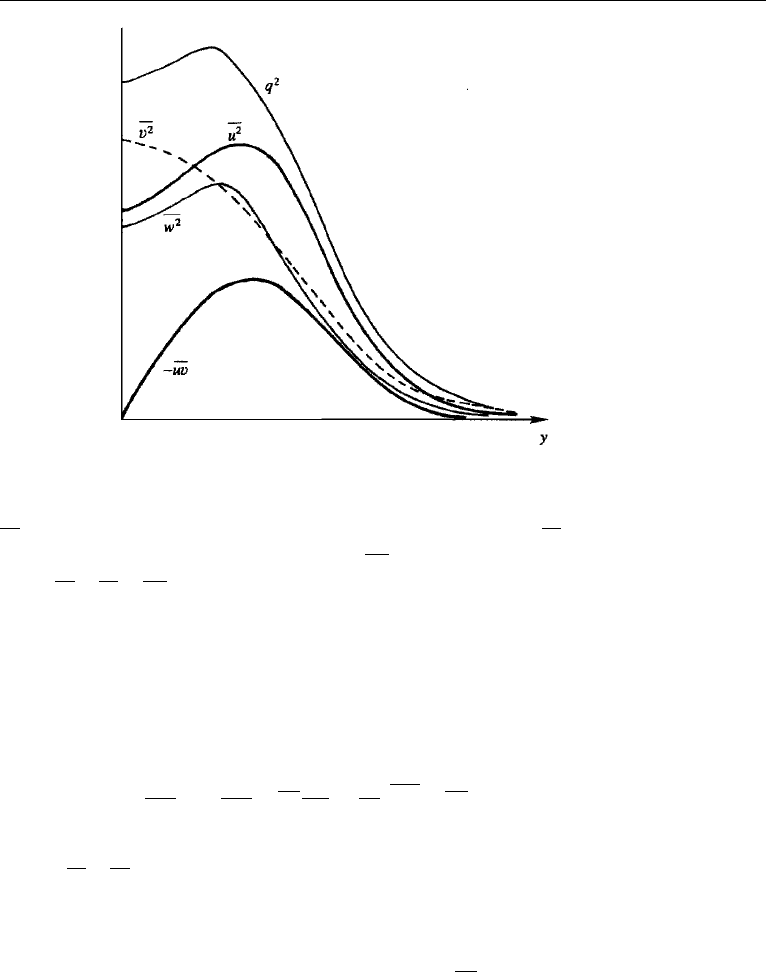
10. Wall-Free Shear Flow 569
Figure 13.15 Sketch of observed variation of turbulent intensity and Reynolds stress across a jet.
the turbulent intensities and Reynolds stress are distributed as in Figure 13.15. Here
u
2
is the intensity of fluctuation in the downstream direction x, v
2
is the inten-
sity along the cross-stream direction y, and
w
2
is the intensity in the z-direction;
q
2
≡ (u
2
+ v
2
+ w
2
)/2 is the turbulent kinetic energy per unit mass. The Reynolds
stress is zero at the center of the jet by symmetry, since there is no reason for v at the
center to be mostly of one sign if u is either positive or negative. The Reynolds stress
reaches a maximum magnitude roughly where ∂U/∂y is maximum. This is also close
to the region where the turbulent kinetic energy reaches a maximum.
Consider now the kinetic energy budget. For a two-dimensional jet under the
boundary layer assumption ∂/∂x ∂/∂y, equation (13.34) becomes
0 =−U
∂q
2
∂x
− V
∂q
2
∂y
−
uv
∂U
∂y
−
∂
∂y
q
2
v + pv/ρ
− ε, (13.46)
where the left-hand side represents ∂q
2
/∂t = 0. Here the viscous transport and
a term (
v
2
− u
2
)(∂U/∂x) arising out of the shear production have been neglected
on the right-hand side because they are small. The balance of terms is analyzed in
Townsend (1976), and the results are shown in Figure 13.16, where T denotes turbulent
transport represented by the fourth term on the right-hand side of (13.46). The shear
production is zero at the center where both ∂U/∂y and
uv are zero, and reaches a
maximum close to the position of the maximum Reynolds stress. Near the center, the
dissipation is primarily balanced by the downstream advection −U(∂q
2
/∂x), which is
positive because the turbulent intensity q
2
decays downstream. Away from the center,
but not too close to the outer edge of the jet, the production and dissipation terms
balance. In the outer parts of the jet, the transport term balances the cross-stream
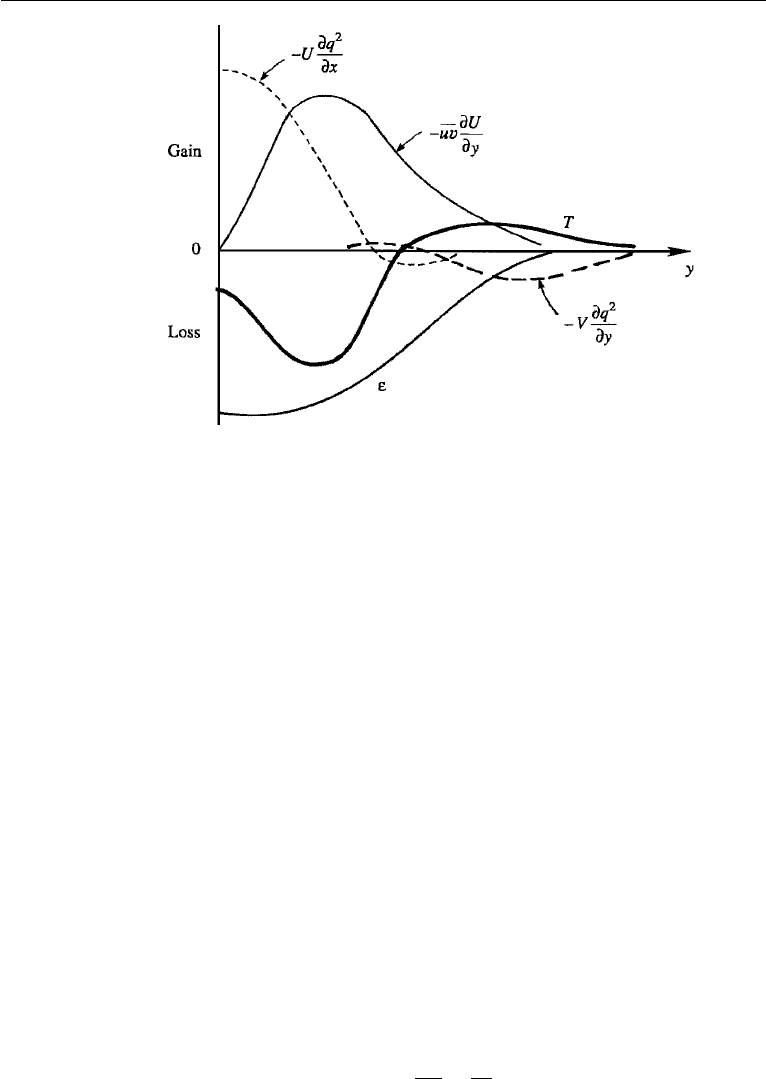
570 Turbulence
Figure 13.16 Sketch of observed kinetic energy budget in a turbulent jet. Turbulent transport is indi-
cated by T .
advection. In this region V is negative (i.e., toward the center) due to entrainment
of the surrounding fluid, and also q
2
decreases with y. Therefore the cross-stream
advection −V(∂q
2
/∂y) is negative, signifying that the entrainment velocity V tends
to decrease the turbulent kinetic energy at the outer edge of the jet. The stationary
state is therefore maintained by the transport term T carrying turbulent kinetic energy
away from the center (where T<0) into the outer parts of the jet (where T>0).
11. Wall-Bounded Shear Flow
The gross characteristics of free shear flows, discussed in the preceding section, are
independent of viscosity. This is not true of a turbulent flow bounded by a solid wall,
in which the presence of viscosity affects the motion near the wall. The effect of
viscosity is reflected in the fact that the drag coefficient of a smooth flat plate depends
on the Reynolds number even for Re →∞, as seen in Figure 10.12. Therefore,
the concept of Reynolds number similarity, which says that the gross characteristics
are independent of Re when Re →∞, no longer applies. In this section we shall
examine how the properties of a turbulent flow near a wall are affected by viscosity.
Before doing this, we shall examine how the Reynolds stress should vary with distance
from the wall.
Consider first a fully developed turbulent flow in a channel. By “fully developed”
we mean that the flow is no longer changing in x (see Figure 9.2). Then the mean
equation of motion is
0 =−
∂P
∂x
+
∂ ¯τ
∂y
,
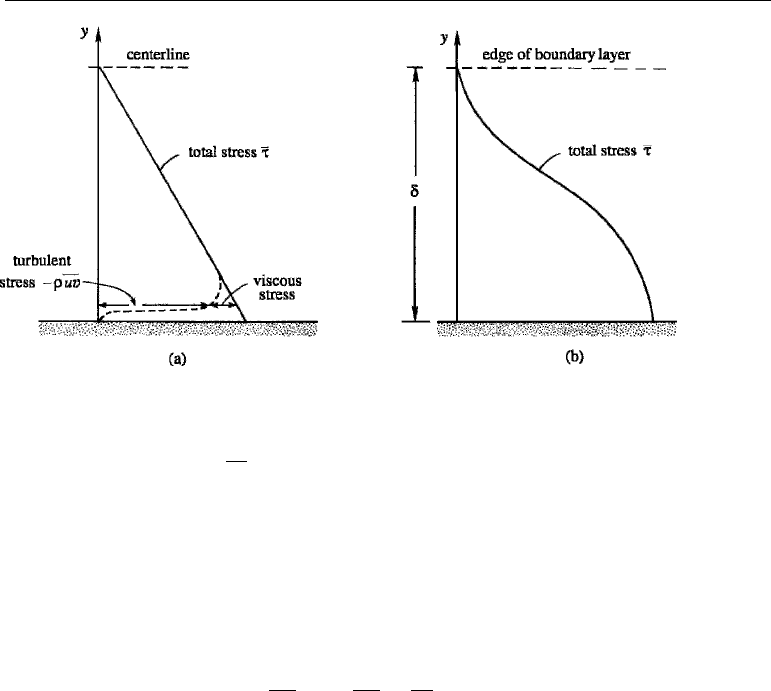
11. Wall-Bounded Shear Flow 571
Figure 13.17 Variation of shear stress across a channel and a boundary layer: (a) channel; and (b) boundary
layer.
where ¯τ = µ(dU/dy) − ρ
uv is the total stress. Because ∂P /∂x is a function of x
alone and ∂ ¯τ/∂y is a function of y alone, both of them must be constants. The stress
distribution is then linear (Figure 13.17a). Away from the wall ¯τ is due mostly to the
Reynolds stress, but close to the wall the viscous contribution dominates. In fact, at
the wall the velocity fluctuations and consequently the Reynolds stresses vanish, so
that the stress is entirely viscous.
In a boundary layer on a flat plate there is no pressure gradient and the mean flow
equation is
ρU
∂U
∂x
+ ρV
∂U
∂y
=
∂ ¯τ
∂y
,
where ¯τ is a function of x and y. The variation of the stress across a boundary layer
is sketched in Figure 13.17b.
Inner Layer: Law of the Wall
Consider the flow near the wall of a channel, pipe, or boundary layer. Let U
∞
be the
free-stream velocity in a boundary layer or the centerline velocity in a channel and
pipe. Let δ be the width of flow, which may be the width of the boundary layer, the
channel half width, or the radius of the pipe. Assume that the wall is smooth, so that
the height of the surface roughness elements is too small to affect the flow. Physical
considerations suggest that the velocity profile near the wall depends only on the
parameters that are relevant near the wall and does not depend on the free-stream
velocity U
∞
or the thickness of the flow δ. Very near a smooth surface, then, we
expect that
U = U(ρ,τ
0
,ν,y), (13.47)
